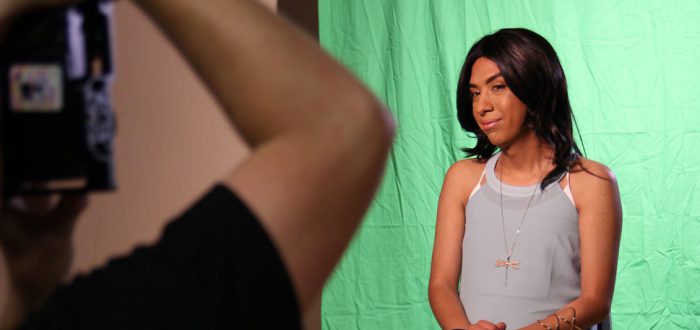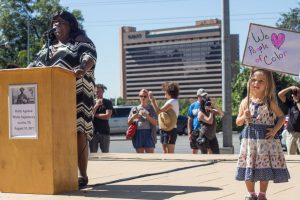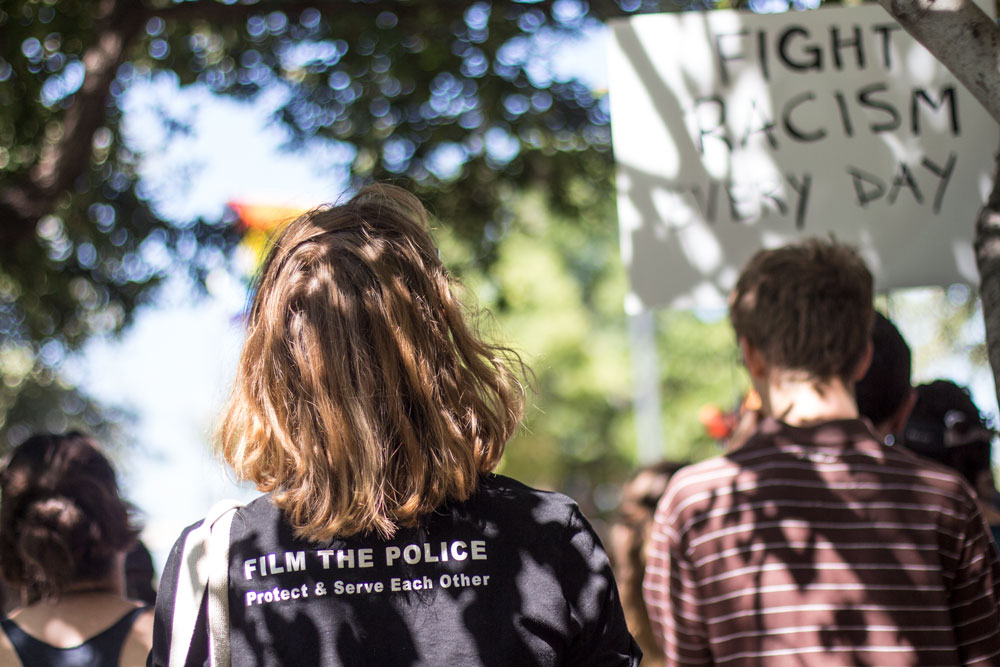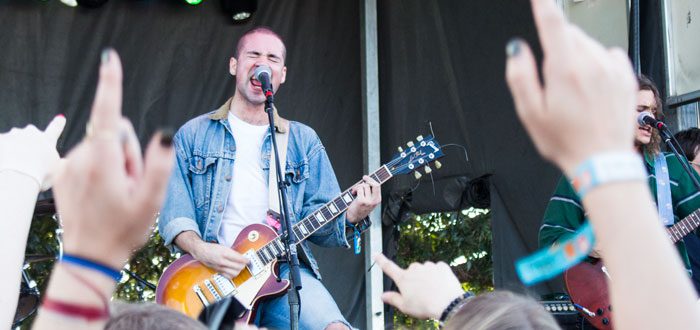Written and Edited by Halie Davis
Filmed by Taylor Kokas
[vc_row][vc_column][vc_column_text]
Blue, pink and white flags were printed on posters that hung up around various campuses this past spring. These colors sandwiched together, horizontally are the Transgender flag. Text on the posters promoted the premiere of a student-made documentary, Transtastic, supported by an LGBTQ resource fair.
Transtastic is the creation of ACC student, Margo De Alva. As a transgender person, she felt the urge to create something that further explains transgender than the textbook definition.
“Coming into the school semester, I was asked several times ‘why do you dress like this?’ ‘Why do you act like this?’” says De Alva. “I just wanted ACC to have a better understanding and I wanted to reach out to people who were in my situation, or are in my situation.”
After graduating from high school, De Alva attempted attending college. But, the timing was off.
“I was very, very sad for several years because I was scared to tell everybody. I didn’t even know what Transgender was. I knew I wanted to be a woman, but I didn’t know the term…I had to venture off to YouTube to even know what transgender meant.”
In recent years, the public has seen more videos, articles and events, regarding transgender people. In 2014, Laverne Cox is the first transgender person on the cover of Time Magazine. Making her public debut at the 2015 ESPYs, Caitlyn Jenner spoke for transgender children and people. That same year and the following, Jeffrey Tambor brought home an Emmy for Leading Actor in Comedy Series, Transparent. In 2016, NPR reported that 1.4 million adults identify as transgender, according to a study done by the Williams Institute at the UCLA School of Law. The highest number of reported deaths among Transgender people, occurred in 2017.
This year Cox poses for the cover of Cosmopolitan
Magazine, Scarlett Johansson apologizes and announces her withdraw from the transgender project, Rub
&
Tug, and Wisconsin is covering two of its residents’ gender confirmation surgeries.
Transgender may be a term that is confusing for the general public to understand, let alone an individual. This past summer, the World Health Organization (WHO) announced that in 2019 being transgender will no longer be considered a mental illness. Often, a fake identity is created by a transgender person to try and fit into society’s standards of male and female roles.
“Dorothy [Alexander] is one of the friends who helped start everything,” De Alva says. “She met me when I was, I guess a boy. She met me and could tell something was up because of the way I acted and stuff. Like she said in [Transtastic], I would joke around about getting my nails done and she’d be like, ‘if you want to get your nails done, I’ll go with you, it’s not a big deal.’ There were times I’d try to act masculine and she’d look at me and and be like, ‘I don’t really feel like this suits you.’ She was just reminding me that ‘I think you’re a different person,’ so when I finally told her, she was like ‘I knew it all along.’”
Some of De Alva’s friends and family were accepting, but not eveyone. At 12-years-old she knew she wanted to be considered a female, but was still unsure about the ways to express herself. “I had no choice but to put on this persona of what I felt like a man or teenage boy was supposed to be, because it was very rough. I was getting picked on in school from the other boys and I remember them telling me ‘you’re such a girl, man up.’”
In her early adolescence, De Alva was living with her dad in the Rundberg area of Austin. This neighborhood is known as a rougher one to many Austinites.
From 2012-2016 Restore Rundberg was a grant received to revitalize the area. Since the funding closed, the Austin Police Department has continued extension programs throughout the area, like Summer in Rundberg to keep the neighborhood children safe when not in school. Restore Rundberg decreased property crime in the area and the city itself.
Crime rates are higher in lower income areas than high-income households, according to the Bureau of Justice Statistics. Some neighborhoods in Austin with a median household income ranging from $7,000 to $38,000 are St. Johns (Rundberg area), North Lamar and East Riverside. Neighborhoods in Austin with a median household income range of $130,000 to $217,000 are Bee Cliffs, Bella Mar and Avery Ranch.
Like many cities, the public education provided to its residents depends on their neighborhood. According to the U.S. News & World Report’s list of Best High Schools in America, Westlake (EISD) ranked 213. Westwood (RRISD) followed up at 221 with a graduation rate of 99 and college readiness score of 72. Vandegrift (LIST) land at 339 while the top ranking AISD school is Anderson at 1,038. Schools like Lanier, Reagan and Eastside Memorial did not place in the national or state rankings. Students at the non-ranking schools live in neighborhoods like East Riverside, North Lamar and St. Johns.
“LGBTQ people are not just on the North side or by Highland.”
DeAlva attended Wooldridge Elementary School, which filters into Lanier High School. These are some of the schools associated with the Rundberg area.
“Rundberg, from my experience, wasn’t necessarily the best place to live at,” De Alva says. “The boys needed to have this role of being tough. In middle school, they were running around, talking about sports…In 2006, I remember being in middle school and LGBT was picked on. Nobody said it was ok.”
De Alva lived with a boy persona until 2015, when she became a junior in high school. At this time, De Alva has moved to the Lakeline area with her grandma. At Westwood High School she was noticing LGBT was more accepted than her previous schools. She was making friends who were openly gay or lesbian. “Their friends weren’t mean about it and they still liked them.”
De Alva was noticing a different world, where people were more accepting and open about being gay. Moreover, she did not feel the urge to live in her previous identity; the one that would mock or ignore people from the LGBT community. “If I had met [an LGBT person] when I was in Rundberg, I would have no choice but to pick on them if I had friends around…my grandma lived in this place where I could listen to how [an LGBT person] felt.”
After taking a break from school, Margo De Alva discovered acceptance in the LGBT community, friends and family. Although hesitant to begin college, Margo found a home in Student Life.
Northridge’s Student Life Coordinator, Tim Prata, assisted Margo with the creation of Transtastic. After listening to her thoughts and hopes, Prata introduced De Alva to ACC’s LGBT eQ Committee and Student Life’s YouTube series, Life4U. From there, the group took De Alva’s documentary idea and created Transtastic. Last March, Transtastic premiered after its resource fair concluded. A Q&A session was held after the documentary premiere with Margo De Alva and others featured in the Transtastic.
“My friends are accepting, so I’ve reached out to several and they have my back with things like ‘hey, I feel uncomfortable going to the bathroom, would you go with me?’ and they will.”
In the 2019 legislative session, many Texans are hoping to continue the discussion about the Bathroom Bill. This bill, defines access to public restrooms by transgender people. In 2015 the Austin City Council passed an ordinance stating that all businesses with a single-use restroom must provide gender-neutral bathrooms. Every ACC campus, with the exception of Riverside, has a family bathroom for its transgender students, faculty and staff. However, having only one single-use bathroom on a campus can be difficult for transgender people – especially if it’s in use.
“LGBTQ people are not just on the north side or by the Highland campus – we’re everywhere,” says De Alva. “There should just be more family bathrooms in general. I can’t tell you how many times I’ve had to hold going to the bathroom because [some business] doesn’t have it.”
Although De Alva’s goal is to live a life as Margo, she chooses not to use the women’s bathroom, even if it’s the only option. “I don’t want to go into the women’s bathroom because I don’t want to alarm females. I’m totally understanding that it can alarm everybody, so I just try to stick to the family bathrooms”
Austin businesses like Alamo Drafthouse at Mueller, Hillside Farmacy and Cheer Up Charlies offer gender-neutral bathrooms. These areas have closed-off stalls for private business and sinks to wash. CEO of Alamo Drafthouse, Tim League, says there are “no complaints at all” in an article from the Austin American Statesman.
De Alva is knowledgeable about which businesses have a restroom for her to use due to personal experience. Fortunately, her support system is able to accompany her to the restroom, if needed. “I’ve had my grandpa tell me ‘if you have to go, I’ll go in there with you and make sure no one says anything…As sweet as that is, it’s humiliating to have to go with my grandfather.”
De Alva says she doesn’t expect sweet gestures, but is thankful for the support. After revealing herself as a transgender person, she’s lost relationships but stays positive. “You’re going to have people that don’t like you no matter what, so you might as well be who you are.”
Margo De Alva plans to transform Transtastic into an event at ACC. She also hopes to open a safe area for the LGBT community to talk and relate with one another. “You know I still have not met someone who is transgender at the school, that I can reach out to. At the event, I started to see more people and they were talking to me and it was great to know that I’m not alone.”
[/vc_column_text][/vc_column][/vc_row][vc_row][vc_column][vc_video link=”https://youtu.be/4EVrIbb-biE”][/vc_column][/vc_row]





 The theme of the protest was to speak out against hate of any sort. Speakers ranged from various areas in the Austin community from Reverent John MacIver Gage to Mayor Steve Adler.
The theme of the protest was to speak out against hate of any sort. Speakers ranged from various areas in the Austin community from Reverent John MacIver Gage to Mayor Steve Adler.